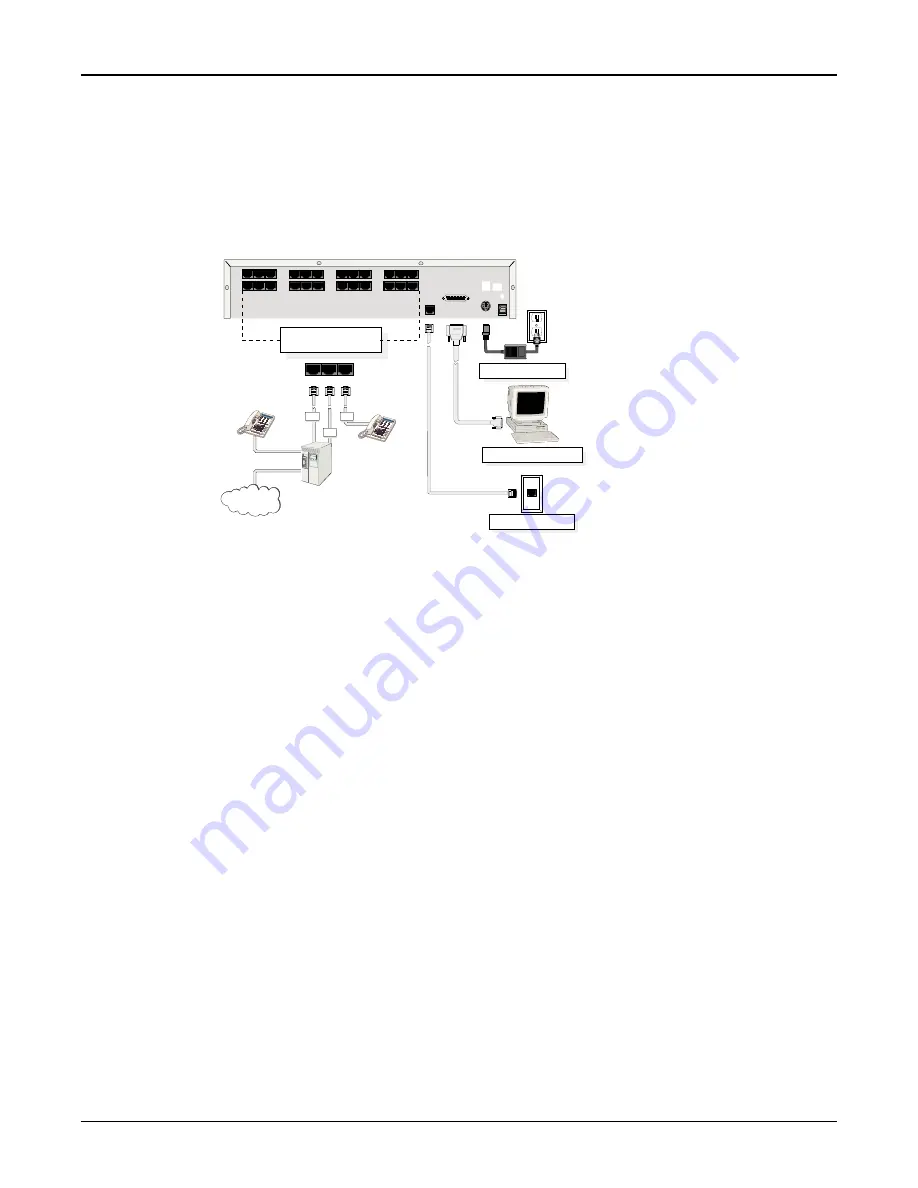
18
MultiVOIP User Guide
Phase 1: Cabling Procedure
Phase 1 cabling involves connecting the master MultiVOIP to your LAN and telephone equipment.
1
If you are connecting any Voice/Fax Channel to an E&M trunk other than type 2, perform the
E&M Jumper Block Positioning procedure before connecting power to the unit.
2
Connect one end of the power supply to a live AC outlet and connect the other end to the
MultiVOIP as shown in Figure 2-2. The power connector is a 7-pin circular DIN connector.
E&M
FXO
FXS
E&M
FXO
FXS
E&M
FXO
FXS
VOICE/
FAX
CHANNEL
8
VOICE/
FAX
CHANNEL
4
VOICE/
FAX
CHANNEL
7
VOICE/
FAX
CHANNEL
3
VOICE/
FAX
CHANNEL
6
VOICE/
FAX
CHANNEL
2
VOICE/
FAX
CHANNEL
5
VOICE/
FAX
CHANNEL
1
CHANNEL 10
CHANNEL 9
CHANNEL 8
CHANNEL 7
CHANNEL 6
CHANNEL 5
CHANNEL 4
CHANNEL 3
CHANNEL 2 (RS232/V.35)
CHANNEL 1 (RS232/V.35)
10BASET
ETHERNET
COMMAND PORT
EXT. COMPOSITE LINK (RS232/V.35)
POWER
I
O
GND
T1 DSU
MONITOR
XMT RCV
INTERNAL
COMPOSITE
LINK
E&M
FXO
FXS
Ethernet Connection
Command Port Connection
Power Connection
FXS
FXO
E&M
FXS
E&M
FXO
PSTN
Voice/Fax Channel 1 - 8
Connections
Figure 2-2. Cable Connections
3
Connect the MultiVOIP to a PC by using the DB-25 (male) to DB-9 (female) cable provided in
your unit. Plug the DB-25 end of the cable into the Command port of the MultiVOIP and the
other end into the PC serial port. See Figure 2-2.
4
Connect a network cable to the ETHERNET 10BASET connector on the back of the
MultiVOIP. Connect the other end of the cable to your network.
5
If you are connecting a station device (e.g., analog telephone, fax machine, or Key Telephone
System (KTS) to your MultiVOIP, connect one end of an RJ11 phone cord to the Voice/Fax
Channel 1 FXS connector on the back of the MultiVOIP and the other end to the station
device.
If you are connecting the station side of a telephone switch (PBX) to your MultiVOIP, connect
one end of an RJ11 phone cord to the Voice/Fax Channel 1 FXO connector on the back of
the MultiVOIP and the other end to the phone jack.
If you are connecting an E&M trunk from a telephone switch to your MultiVOIP, connect one
end of an RJ45 phone cord to the Voice/Fax Channel 1 E&M connector on the back of the
MultiVOIP and the other end to the trunk. Refer to Appendix B for E&M cabling pinout.
If you are connecting to an E&M trunk, you need ensure that the E&M trunk jumper is in the
correct position for the E&M type trunk. The default E&M jumper position is E&M type 2. To
change the E&M jumper position, perform the E&M jumper block positioning procedure.
6
Repeat the above step to connect the remaining telephone equipment to each Voice/Fax
Channel on your MultiVOIP.
7
Turn on power to the MultiVOIP by placing the ON/OFF switch on the back panel to the ON
position. Wait for the BTG LED on the MultiVOIP to go OFF before proceeding. This may
take a couple of minutes to go OFF.
Proceed to the next section to load the MultiVOIP software.
Summary of Contents for MultiVOIP 400
Page 1: ...Standalone Voice IP Gateway Models MVP400 and MVP 800 User Guide...
Page 5: ...Chapter 1 Introduction and Description...
Page 14: ...14 MultiVOIP User Guide...
Page 15: ...Chapter 2 Installation...
Page 20: ...20 MultiVOIP User Guide...
Page 21: ...Chapter 3 Software Loading and Configuration...
Page 39: ...Chapter 4 MultiVOIP Software...
Page 53: ...Chapter 5 Remote Configuration and Management...
Page 61: ...Chapter 6 Warranty Service and Tech Support...
Page 66: ...66 MultiVOIP User Guide...
Page 67: ...Appendixes...
Page 75: ...Glossary...
















































